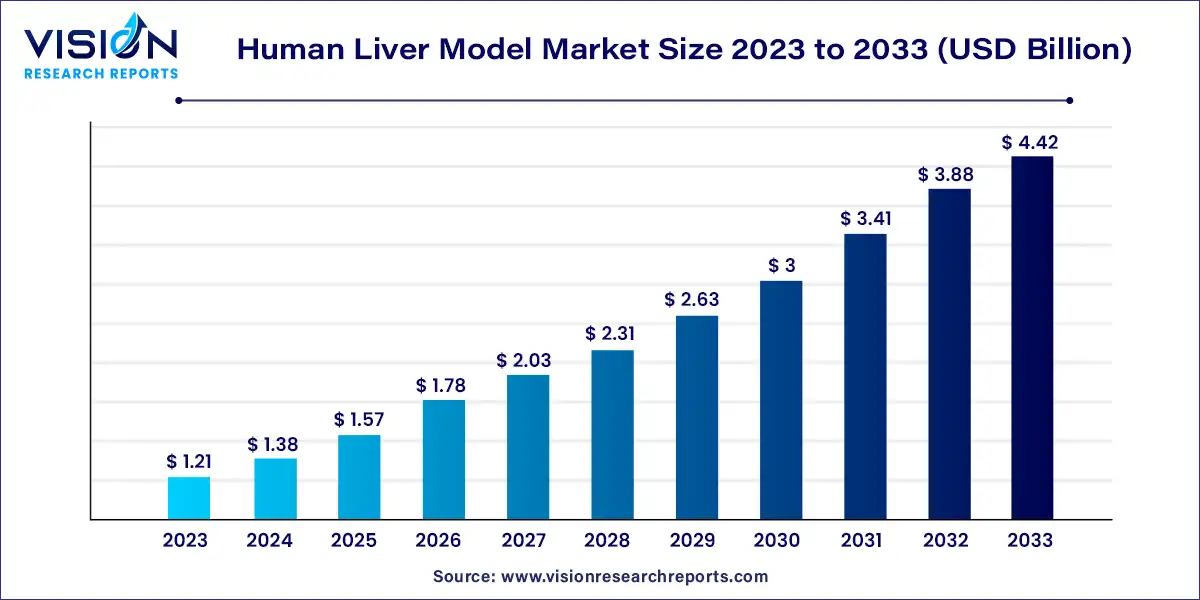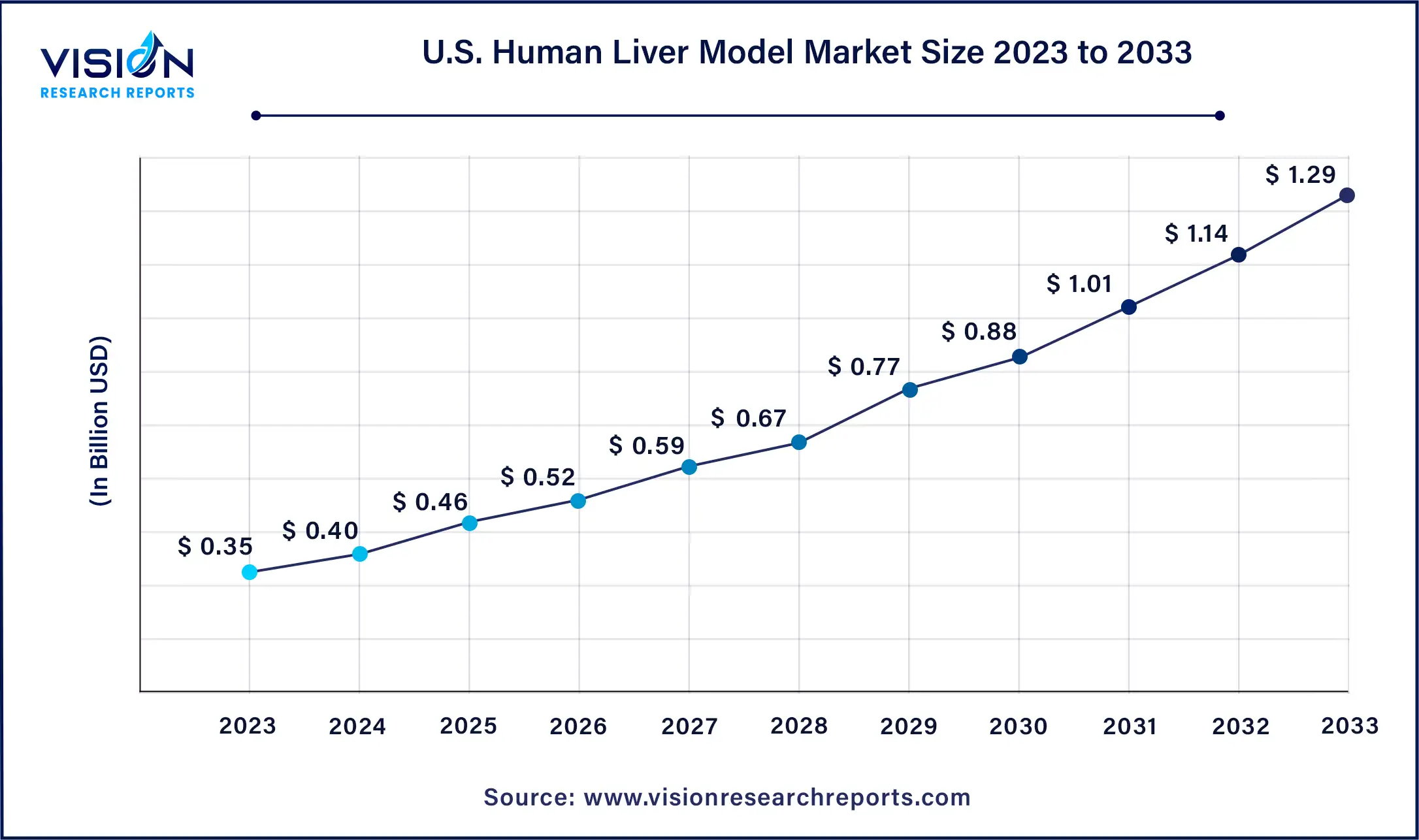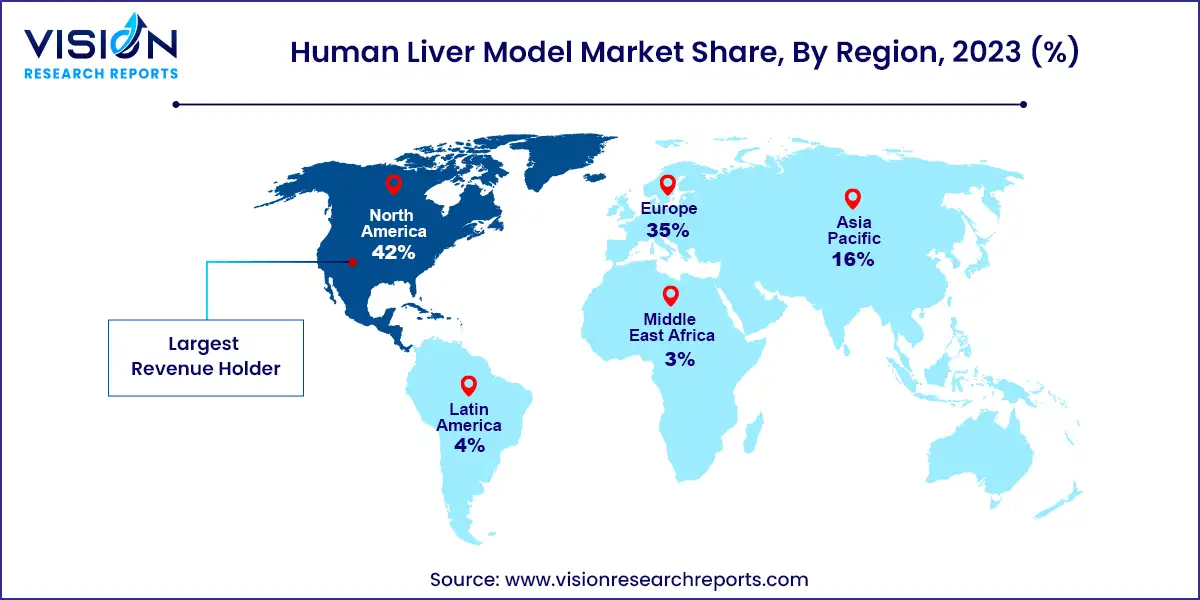The global human liver mode market size was estimated at USD 1.21 billion in 2023 and it is expected to surpass around USD 4.42 billion by 2033, poised to grow at a CAGR of 13.83% from 2024 to 2033.

The human liver model market is experiencing significant growth due to the increasing demand for advanced models in drug discovery, toxicity testing, and disease modeling. These models are essential for understanding liver function and pathology, providing critical insights that can lead to the development of new treatments and therapies.
The growth of the human liver model market is propelled by an advancement in biotechnological methods, such as 3D bioprinting and organ-on-a-chip technologies, has significantly enhanced the accuracy and functionality of liver models, making them indispensable tools in drug discovery and toxicity testing. Additionally, the increasing prevalence of liver diseases like hepatitis, fatty liver disease, and liver cancer drives the demand for sophisticated liver models to better understand these conditions and develop effective treatments. Furthermore, the pharmaceutical industry's growing focus on reducing late-stage drug development failures by identifying hepatotoxicity early in the pipeline is boosting the adoption of these models. Collectively, these factors contribute to the robust expansion of the human liver model market.
North America dominated the human liver model market with the largest revenue share of 42% in 2023, due to several unique factors. The region benefits from a robust healthcare infrastructure and favorable regulatory environment that supports the adoption of advanced technologies such as human liver models for preclinical drug testing. North America boasts a high concentration of leading academic research institutions, biotech start-ups, and pharmaceutical companies that drive innovation and collaboration in liver disease research and drug development.
| Attribute | North America |
| Market Value | USD 0.50 Billion |
| Growth Rate | 13.83% CAGR |
| Projected Value | USD 1.85 Billion |
The U.S. human liver mode market size was valued at USD 0.35 billion in 2023 and is expected to hit around USD 1.29 billion by 2033, poised to grow at a CAGR of 13.83% from 2024 to 2033.

The human liver model market in the U.S. is anticipated to grow at the fastest CAGR during the forecast period. A strong emphasis on personalized medicine and the use of advanced technologies characterizes the U.S. market. The country's healthcare system encourages the adoption of innovative solutions, such as organ-on-a-chip devices, which can simulate the function of human livers. According to the CDC, 4.5 million adults aged 18 and older are living with liver disease in the U.S. Hence, the adoption of liver models is expected to increase in this country in the coming years.
The human liver model market in Europe is witnessing several notable trends. One significant trend is the increasing adoption of advanced technologies such as 3D bioprinting and organ-on-a-chip systems for developing more accurate and physiologically relevant liver models. These innovative technologies enable researchers to mimic the complex microenvironment of the liver, leading to improved drug testing and disease modeling capabilities.

The human liver model market in Asia Pacific is expected to grow at the fastest CAGR during the forecast period. One significant trend driving this growth is the increasing prevalence of liver diseases in the region, such as hepatitis and liver cancer, which has led to a higher demand for advanced research tools such as human liver models. Additionally, rising investments in healthcare infrastructure and research and development activities in China, Japan, and India fuel market expansion.
The 2D models segment led the market with the largest revenue share of 83% in 2023. This dominance is primarily due to the widespread adoption of 2D models in pharmaceutical research and drug development, owing to their cost-effectiveness and simplicity compared to more complex 3D models. Additionally, the ease of use and well-established protocols for 2D models make them a preferred choice for many researchers. The high demand for screening compounds for hepatotoxicity testing further supports the prevalence of 2D models, as they are efficient and reliable for various research applications.
The 3D models segment is projected to witness the fastest CAGR of 14.93% from 2024 to 2033, attributed to its ability to closely mimic the complex structure and function of the human liver. These models offer a more accurate representation of in vivo conditions, making them valuable tools for drug development, disease modeling, and personalized medicine. For example, Emulate Inc. offers organ-on-a-chip technology that recreates the microenvironment of human organs, including the liver, allowing for more precise testing of drug responses and toxicity levels.
Based on application, the ADME (absorption, distribution, metabolism, and excretion) studies segment led the market with the largest revenue share of 40% in 2023. The increasing demand for accurate and efficient drug development and testing processes drives this segment. By utilizing human liver models for ADME studies, researchers can simulate human physiological conditions more accurately, leading to better predictions of drug behavior in humans. Consequently, there is a high demand for liver models in the biopharmaceuticals industry, boosting the segment's growth.
The toxicology testing segment is projected to exhibit the fastest CAGR of 14.83% from 2024 to 2033. This growth can be attributed to the increasing demand for more accurate and predictive in vitro models to assess the safety and efficacy of new drug candidates, chemicals, and cosmetic ingredients. Pharmaceutical and chemical companies are increasingly adopting human liver models, such as 3D bioprinted liver tissues and organ-on-a-chip platforms, to replace traditional animal testing methods, which often fail to predict human-specific responses accurately. These factors are likely to drive the segment's growth.
Based on end use, the pharmaceutical and biotechnology segment led the market with the largest revenue share of 49% in 2023. This dominance is primarily driven by the increasing demand for advanced liver models for drug development and toxicity testing within these industries. During preclinical studies, pharmaceutical and biotechnology companies rely heavily on human liver models to assess drug metabolism, drug-drug interactions, and hepatotoxicity. Using human liver models allows these companies to enhance the efficiency and accuracy of their drug development processes, leading to cost savings and reduced time-to-market for new pharmaceutical products.
The contract research organizations (CROs) segment is anticipated to witness the fastest CAGR of 14.53% from 2024 to 2033. The increasing demand for personalized medicine and the rising prevalence of liver diseases propel the need for advanced research and development in this field. CROs offer specialized services and expertise that pharmaceutical companies and research institutions can leverage to accelerate drug discovery processes related to liver diseases.
By Product
By Application
By End-use
By Region
Chapter 1. Introduction
1.1. Research Objective
1.2. Scope of the Study
1.3. Definition
Chapter 2. Research Methodology
2.1. Research Approach
2.2. Data Sources
2.3. Assumptions & Limitations
Chapter 3. Executive Summary
3.1. Market Snapshot
Chapter 4. Market Variables and Scope
4.1. Introduction
4.2. Market Classification and Scope
4.3. Industry Value Chain Analysis
4.3.1. Raw Material Procurement Analysis
4.3.2. Sales and Distribution Product Analysis
4.3.3. Downstream Buyer Analysis
Chapter 5. COVID 19 Impact on Human Liver Model Market
5.1. COVID-19 Landscape: Human Liver Model Industry Impact
5.2. COVID 19 - Impact Assessment for the Industry
5.3. COVID 19 Impact: Global Major Government Policy
5.4. Market Trends and Opportunities in the COVID-19 Landscape
Chapter 6. Market Dynamics Analysis and Trends
6.1. Market Dynamics
6.1.1. Market Drivers
6.1.2. Market Restraints
6.1.3. Market Opportunities
6.2. Porter’s Five Forces Analysis
6.2.1. Bargaining power of suppliers
6.2.2. Bargaining power of buyers
6.2.3. Threat of substitute
6.2.4. Threat of new entrants
6.2.5. Degree of competition
Chapter 7. Competitive Landscape
7.1.1. Company Market Share/Positioning Analysis
7.1.2. Key Strategies Adopted by Players
7.1.3. Vendor Landscape
7.1.3.1. List of Suppliers
7.1.3.2. List of Buyers
Chapter 8. Global Human Liver Model Market, By Product
8.1. Human Liver Model Market, by Product, 2024-2033
8.1.1 2D Models
8.1.1.1. Market Revenue and Forecast (2021-2033)
8.1.2. 3D Models
8.1.2.1. Market Revenue and Forecast (2021-2033)
Chapter 9. Global Human Liver Model Market, By Application
9.1. Human Liver Model Market, by Application, 2024-2033
9.1.1. ADME Studies
9.1.1.1. Market Revenue and Forecast (2021-2033)
9.1.2. Toxicology Testing
9.1.2.1. Market Revenue and Forecast (2021-2033)
9.1.3. Disease Modelling
9.1.3.1. Market Revenue and Forecast (2021-2033)
9.1.4. Others
9.1.4.1. Market Revenue and Forecast (2021-2033)
Chapter 10. Global Human Liver Model Market, By End-use
10.1. Human Liver Model Market, by End-use, 2024-2033
10.1.1. Academic & Research Institutes
10.1.1.1. Market Revenue and Forecast (2021-2033)
10.1.2. Pharmaceutical & Biotechnology Companies
10.1.2.1. Market Revenue and Forecast (2021-2033)
10.1.3. Contract Research Organizations
10.1.3.1. Market Revenue and Forecast (2021-2033)
Chapter 11. Global Human Liver Model Market, Regional Estimates and Trend Forecast
11.1. North America
11.1.1. Market Revenue and Forecast, by Product (2021-2033)
11.1.2. Market Revenue and Forecast, by Application (2021-2033)
11.1.3. Market Revenue and Forecast, by End-use (2021-2033)
11.1.4. U.S.
11.1.4.1. Market Revenue and Forecast, by Product (2021-2033)
11.1.4.2. Market Revenue and Forecast, by Application (2021-2033)
11.1.4.3. Market Revenue and Forecast, by End-use (2021-2033)
11.1.5. Rest of North America
11.1.5.1. Market Revenue and Forecast, by Product (2021-2033)
11.1.5.2. Market Revenue and Forecast, by Application (2021-2033)
11.1.5.3. Market Revenue and Forecast, by End-use (2021-2033)
11.2. Europe
11.2.1. Market Revenue and Forecast, by Product (2021-2033)
11.2.2. Market Revenue and Forecast, by Application (2021-2033)
11.2.3. Market Revenue and Forecast, by End-use (2021-2033)
11.2.4. UK
11.2.4.1. Market Revenue and Forecast, by Product (2021-2033)
11.2.4.2. Market Revenue and Forecast, by Application (2021-2033)
11.2.4.3. Market Revenue and Forecast, by End-use (2021-2033)
11.2.5. Germany
11.2.5.1. Market Revenue and Forecast, by Product (2021-2033)
11.2.5.2. Market Revenue and Forecast, by Application (2021-2033)
11.2.5.3. Market Revenue and Forecast, by End-use (2021-2033)
11.2.6. France
11.2.6.1. Market Revenue and Forecast, by Product (2021-2033)
11.2.6.2. Market Revenue and Forecast, by Application (2021-2033)
11.2.6.3. Market Revenue and Forecast, by End-use (2021-2033)
11.2.7. Rest of Europe
11.2.7.1. Market Revenue and Forecast, by Product (2021-2033)
11.2.7.2. Market Revenue and Forecast, by Application (2021-2033)
11.2.7.3. Market Revenue and Forecast, by End-use (2021-2033)
11.3. APAC
11.3.1. Market Revenue and Forecast, by Product (2021-2033)
11.3.2. Market Revenue and Forecast, by Application (2021-2033)
11.3.3. Market Revenue and Forecast, by End-use (2021-2033)
11.3.4. India
11.3.4.1. Market Revenue and Forecast, by Product (2021-2033)
11.3.4.2. Market Revenue and Forecast, by Application (2021-2033)
11.3.4.3. Market Revenue and Forecast, by End-use (2021-2033)
11.3.5. China
11.3.5.1. Market Revenue and Forecast, by Product (2021-2033)
11.3.5.2. Market Revenue and Forecast, by Application (2021-2033)
11.3.5.3. Market Revenue and Forecast, by End-use (2021-2033)
11.3.6. Japan
11.3.6.1. Market Revenue and Forecast, by Product (2021-2033)
11.3.6.2. Market Revenue and Forecast, by Application (2021-2033)
11.3.6.3. Market Revenue and Forecast, by End-use (2021-2033)
11.3.7. Rest of APAC
11.3.7.1. Market Revenue and Forecast, by Product (2021-2033)
11.3.7.2. Market Revenue and Forecast, by Application (2021-2033)
11.3.7.3. Market Revenue and Forecast, by End-use (2021-2033)
11.4. MEA
11.4.1. Market Revenue and Forecast, by Product (2021-2033)
11.4.2. Market Revenue and Forecast, by Application (2021-2033)
11.4.3. Market Revenue and Forecast, by End-use (2021-2033)
11.4.4. GCC
11.4.4.1. Market Revenue and Forecast, by Product (2021-2033)
11.4.4.2. Market Revenue and Forecast, by Application (2021-2033)
11.4.4.3. Market Revenue and Forecast, by End-use (2021-2033)
11.4.5. North Africa
11.4.5.1. Market Revenue and Forecast, by Product (2021-2033)
11.4.5.2. Market Revenue and Forecast, by Application (2021-2033)
11.4.5.3. Market Revenue and Forecast, by End-use (2021-2033)
11.4.6. South Africa
11.4.6.1. Market Revenue and Forecast, by Product (2021-2033)
11.4.6.2. Market Revenue and Forecast, by Application (2021-2033)
11.4.6.3. Market Revenue and Forecast, by End-use (2021-2033)
11.4.7. Rest of MEA
11.4.7.1. Market Revenue and Forecast, by Product (2021-2033)
11.4.7.2. Market Revenue and Forecast, by Application (2021-2033)
11.4.7.3. Market Revenue and Forecast, by End-use (2021-2033)
11.5. Latin America
11.5.1. Market Revenue and Forecast, by Product (2021-2033)
11.5.2. Market Revenue and Forecast, by Application (2021-2033)
11.5.3. Market Revenue and Forecast, by End-use (2021-2033)
11.5.4. Brazil
11.5.4.1. Market Revenue and Forecast, by Product (2021-2033)
11.5.4.2. Market Revenue and Forecast, by Application (2021-2033)
11.5.4.3. Market Revenue and Forecast, by End-use (2021-2033)
11.5.5. Rest of LATAM
11.5.5.1. Market Revenue and Forecast, by Product (2021-2033)
11.5.5.2. Market Revenue and Forecast, by Application (2021-2033)
11.5.5.3. Market Revenue and Forecast, by End-use (2021-2033)
Chapter 12. Company Profiles
12.1. ATCC.
12.1.1. Company Overview
12.1.2. Product Offerings
12.1.3. Financial Performance
12.1.4. Recent Initiatives
12.2. Merck KGaA.
12.2.1. Company Overview
12.2.2. Product Offerings
12.2.3. Financial Performance
12.2.4. Recent Initiatives
12.3. AcceGen.
12.3.1. Company Overview
12.3.2. Product Offerings
12.3.3. Financial Performance
12.3.4. Recent Initiatives
12.4. ZenBio, Inc.
12.4.1. Company Overview
12.4.2. Product Offerings
12.4.3. Financial Performance
12.4.4. Recent Initiatives
12.5. Organovo Holdings Inc.
12.5.1. Company Overview
12.5.2. Product Offerings
12.5.3. Financial Performance
12.5.4. Recent Initiatives
12.6. BioIVT
12.6.1. Company Overview
12.6.2. Product Offerings
12.6.3. Financial Performance
12.6.4. Recent Initiatives
12.7. InSphero.
12.7.1. Company Overview
12.7.2. Product Offerings
12.7.3. Financial Performance
12.7.4. Recent Initiatives
12.8. Emulate, Inc.
12.8.1. Company Overview
12.8.2. Product Offerings
12.8.3. Financial Performance
12.8.4. Recent Initiatives
12.9. Mimetas.
12.9.1. Company Overview
12.9.2. Product Offerings
12.9.3. Financial Performance
12.9.4. Recent Initiatives
12.10. CN Bio Innovations Ltd
12.10.1. Company Overview
12.10.2. Product Offerings
12.10.3. Financial Performance
12.10.4. Recent Initiatives
Chapter 13. Research Methodology
13.1. Primary Research
13.2. Secondary Research
13.3. Assumptions
Chapter 14. Appendix
14.1. About Us
14.2. Glossary of Terms
 Cross-segment Market Size and Analysis for
Mentioned Segments
Cross-segment Market Size and Analysis for
Mentioned Segments
 Additional Company Profiles (Upto 5 With No Cost)
Additional Company Profiles (Upto 5 With No Cost)
 Additional Countries (Apart From Mentioned Countries)
Additional Countries (Apart From Mentioned Countries)
 Country/Region-specific Report
Country/Region-specific Report
 Go To Market Strategy
Go To Market Strategy
 Region Specific Market Dynamics
Region Specific Market Dynamics Region Level Market Share
Region Level Market Share Import Export Analysis
Import Export Analysis Production Analysis
Production Analysis Others
Others